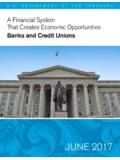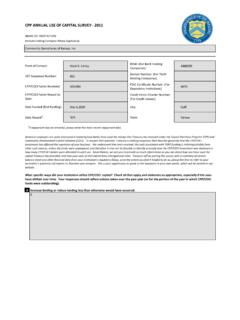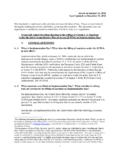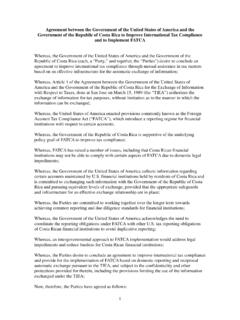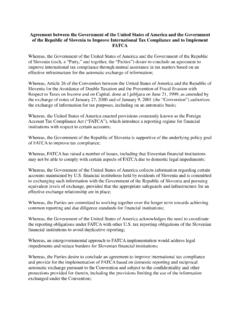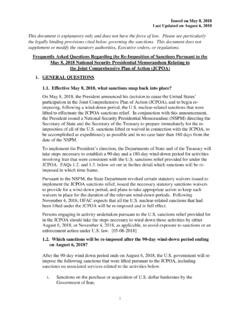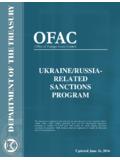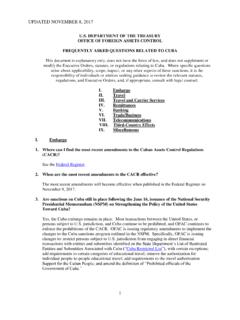Transcription of An Economic Analysis of Infrastructure Investment
1 An Economic Analysis ofInfrastructure InvestmentThe Department of the Treasurywith the Council of Economic AdvisersOctober 11, 2010 AN Economic Analysis OF Infrastructure Investment A REPORT PREPARED BY THE DEPARTMENT OF THE TREASURY WITH THE COUNCIL OF Economic ADVISERS OCTOBER 11, 2010 1 Executive Summary On Labor Day, President Obama announced a bold plan to renew and expand America s Infrastructure . The plan includes a $50 billion up-front Investment connected to a six-year reauthorization of the surface transportation program and the creation of a National Infrastructure Bank to leverage private capital and select projects of regional and national significance. The Department of the Treasury, with the Council of Economic Advisers, has conducted an Analysis of the Economic effects of transportation Infrastructure Investment .
2 Our Analysis found four key reasons why now is an optimal time to increase our Investment in transportation Infrastructure : Well designed Infrastructure investments have long term Economic benefits; The middle class will benefit disproportionately from this Investment ; There is currently a high level of underutilized resources that can be used to improve and expand our Infrastructure ; and There is strong demand by the public and businesses for additional transportation Infrastructure investments. Return on Investment Many studies have found evidence of large private sector productivity gains from public Infrastructure investments, in many cases with higher returns than private capital Investment .
3 Research has shown that well designed Infrastructure investments can raise Economic growth, productivity, and land values, while also providing significant positive spillovers to areas such as Economic development, energy efficiency, public health and manufacturing. Not all Infrastructure projects are worth the Investment . Investing rationally in Infrastructure is critically important, as is providing opportunities for the private sector to invest in public Infrastructure . There is currently very little direct private Investment in our nation s highway and transit systems due to the current method of funding Infrastructure , which lacks effective mechanisms to attract and repay direct private Investment in specific Infrastructure projects.
4 The establishment of a National Infrastructure Bank would create the conditions for greater private sector co- Investment in Infrastructure projects. A National Infrastructure Bank would also perform a rigorous Analysis that would result in support for projects that yield the greatest returns to society and are most likely to deliver long-run Economic benefits that justify the up-front investments. 2 Helping the Middle Class Investing in transportation Infrastructure creates middle class jobs. Our Analysis suggests that 61 percent of the jobs directly created by investing in Infrastructure would be in the construction sector, 12 percent would be in the manufacturing sector, and 7 percent would be in retail trade, for a total of 80 percent in these three sectors.
5 Nearly 90 percent of the jobs in the three sectors most affected by Infrastructure spending would be middle class jobs, defined as those paying between the 25th and 75th percentile of the national distribution of wages. The President s proposal emphasizes transportation choices, including mass transit and high speed rail, to deliver the greatest long-term benefits to those who need it most: middle class families. The average American family spends more than $8,600 a year on transportation, one-third more than they spend on food. For the 90 percent of Americans who are not among the top decile in income, transportation costs absorb one out of every six dollars of income. This burden is due in large part to the lack of alternatives to expensive and often congested automobile travel.
6 Multi-modal transportation investments are critical to get American families moving again without wasting their time and their money sitting in traffic. Investing in Infrastructure Uses Underutilized Resources The average unemployment rate among those who gain employment as a result of additional Investment in Infrastructure is currently over 15 percent. This is more than one and one-half times the national unemployment rate. Within the construction sector, where the majority of direct employment occurs as a result of Infrastructure Investment , the unemployment rate is over 17 percent. Construction costs and other costs associated with building projects are especially low in the current environment.
7 The Department of Transportation s (DOT) experience with Recovery Act funding has shown that more than 2,000 additional airport, highway, bridge and transit projects were funded because of low bids, or projects being completed under budget. DOT also reported that among its $ billion in aviation investments, winning bids for the projects came in $200 million below their initial engineering estimates. 3 Americans Want Additional Investment As a result of years of under- Investment in our transportation system, Americans satisfaction with our public transit system, when compared to public satisfaction with public transit systems around the world, ranks 25th out of 32 OECD nations. While our nation has historically favored road building over public transit, we rank only 17th out of 32 -- in the middle of the pack -- with respect to our satisfaction with our roads and highways.
8 The relatively higher satisfaction with roads and highways is consistent with the observation that our nation s historic Investment pattern favored highways and roads over public transit. One study found that almost 19 out of 20 Americans are concerned about America s Infrastructure and 84 percent support greater Investment to address Infrastructure problems. 4 An Economic Analysis of Infrastructure Investment I. Introduction On Labor Day, President Obama announced a bold plan to renew and expand America s Infrastructure . This plan includes a $50 billion up-front Investment connected to a six-year reauthorization of the surface transportation program and the creation of a National Infrastructure Bank.
9 The President s plan would rebuild 150,000 miles of roads, construct and maintain 4,000 miles of passenger rail, rehabilitate or reconstruct 150 miles of runways while upgrading our outdated air traffic control system, bringing American aviation travel into the 21st century. This report considers various Economic effects of Infrastructure investments. Public Infrastructure is an essential part of the economy. Every day, Americans use our nation s transportation Infrastructure to commute to work, visit their friends and family and travel freely around the country. Businesses depend on a well functioning Infrastructure system to obtain their supplies, manage their inventories, and deliver their goods and services to market.
10 This is true for companies whose businesses rely directly on the Infrastructure system, such as UPS and CSX, as well as others whose businesses indirectly rely on the Infrastructure system, such as farmers who use publicly funded Infrastructure to ship crops to buyers, and companies that send goods purchased online to customers throughout the world. A modern transportation Infrastructure network is necessary for our economy to function, and is a prerequisite for future growth. President Eisenhower s vision is even more relevant today than it was in 1955, when in his State of the Union Address he said, "A modern, efficient highway system is essential to meet the needs of our growing population, our expanding economy, and our national security.
